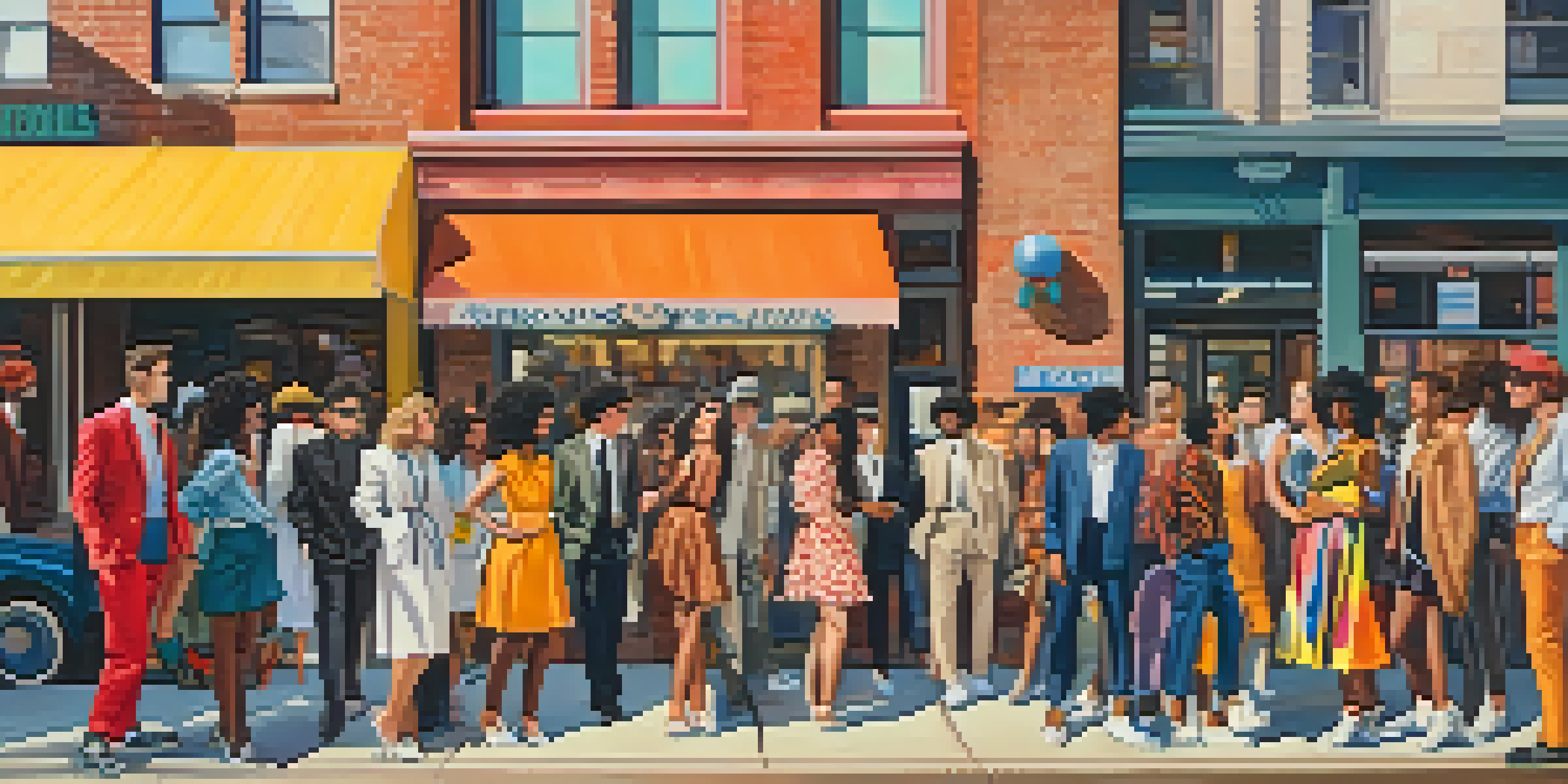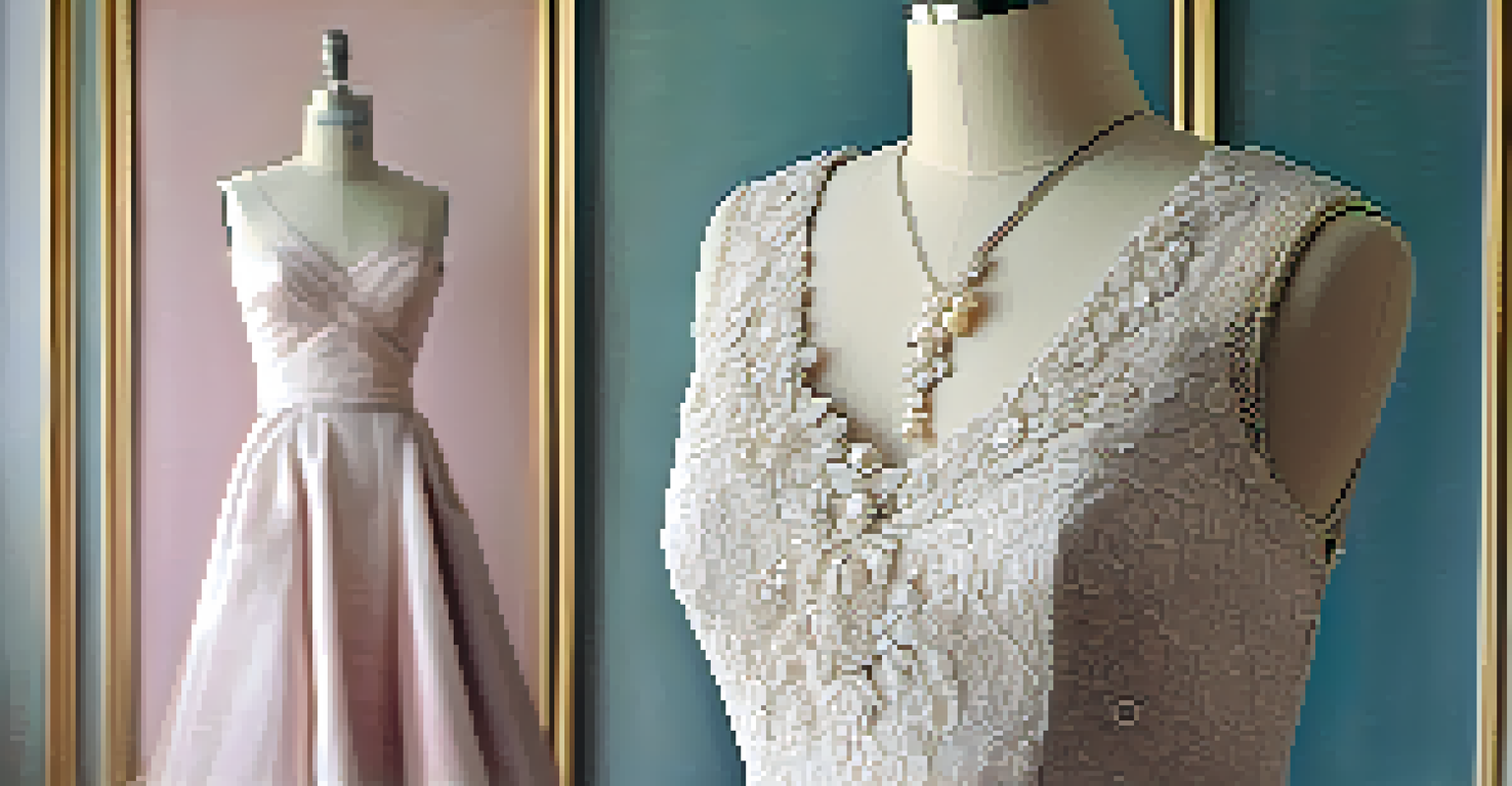Cultural Impact of Vintage Fashion on Modern Trends

The Roots of Vintage Fashion: A Brief Overview
Vintage fashion refers to clothing and accessories from previous decades that hold historical significance. Often associated with styles from the 1920s to the 1990s, these pieces tell stories of their time and reflect the cultural context in which they were created. As society evolves, revisiting these styles allows us to connect with our past and appreciate the artistry involved in fashion design.
Fashion is the armor to survive the reality of everyday life.
The resurgence of vintage clothing has seen a remarkable growth in popularity, especially among millennials and Gen Z. Platforms like Instagram and TikTok have made it easier for vintage enthusiasts to share their finds and style inspirations, creating a community around sustainable fashion choices. This trend not only promotes the idea of recycling clothes but also encourages creativity in personal style.
Vintage fashion often serves as a canvas for self-expression, allowing individuals to mix and match pieces from different eras. By incorporating vintage elements into contemporary wardrobes, people can create unique looks that stand out, showcasing their personality and perspective. This blending of old and new fosters a deeper appreciation for both fashion history and modern design.
Sustainability: The Green Side of Vintage Fashion
As the fashion industry grapples with environmental concerns, vintage fashion emerges as a sustainable alternative. By choosing second-hand clothing, consumers reduce waste and minimize their carbon footprint, which is crucial in an era of fast fashion. Vintage pieces not only have a unique charm but also offer an eco-friendly way to stay stylish.

The sustainability movement has sparked a shift in consumer behavior, with more people seeking out vintage shops and thrift stores. This growing demand encourages businesses to focus on sourcing quality vintage items, fostering a culture of reuse rather than disposal. As a result, vintage fashion promotes responsible consumption and celebrates the craftsmanship of past designers.
Vintage Fashion's Sustainability Appeal
Choosing vintage clothing reduces waste and promotes responsible consumption, making it an eco-friendly fashion choice.
Moreover, the impact of vintage fashion on sustainability extends beyond individual choices. It encourages brands to rethink their production methods and consider sustainable practices in their collections. This shift towards eco-consciousness in fashion reflects a broader cultural change, where consumers prioritize ethical standards and environmental impact.
Nostalgia and Its Role in Modern Fashion
Nostalgia plays a significant role in the appeal of vintage fashion, as many people yearn for the aesthetics and simplicity of past decades. This longing for 'the good old days' allows fashion to serve as a time capsule, transporting us back to different eras and evoking fond memories. Designers often tap into this sentiment, drawing inspiration from nostalgic styles to create modern collections.
Vintage clothing is like a time capsule that allows us to express our identity through the stories of the past.
The cyclical nature of fashion means that trends often come back around, allowing vintage styles to regain popularity. For example, the resurgence of 90s fashion has led to a revival of baggy jeans, crop tops, and platform shoes. Such trends not only bring back memories for those who lived through the era but also introduce younger generations to classic styles.
Through nostalgia, vintage fashion connects generations, fostering conversations about style and cultural heritage. When people wear vintage pieces, they often share stories about their past, creating a sense of community and shared experience. This emotional connection enhances the value of vintage clothing, making it much more than just a fashion statement.
Influence of Pop Culture on Vintage Fashion Trends
Pop culture has a profound impact on fashion trends, and vintage pieces often make a comeback thanks to movies, music, and celebrities. Iconic films and TV shows frequently showcase vintage styles, influencing audiences to adopt similar looks. For instance, the popularity of shows like 'Stranger Things' has rekindled interest in 80s and 90s fashion, inspiring fans to explore thrift stores for authentic pieces.
Music also plays a pivotal role in shaping fashion trends. From rock and punk influences to hip-hop and R&B, various genres promote distinctive styles that often draw from past decades. Artists like Billie Eilish and Harry Styles have popularized vintage aesthetics, encouraging fans to embrace eclectic fashion choices that defy conventional norms.
Nostalgia Drives Vintage Fashion Trends
The emotional connection to past styles fosters nostalgia, influencing both individual choices and modern fashion trends.
Additionally, social media platforms amplify the influence of pop culture, allowing trends to spread rapidly. Fashion influencers often showcase vintage finds, creating a ripple effect that inspires their followers. This interconnectedness between pop culture and vintage fashion drives innovation while honoring the styles that paved the way.
The Role of Vintage Fashion in Individual Identity
Vintage fashion allows individuals to express their identity in unique ways. By curating a wardrobe filled with vintage pieces, people can showcase their personal style and values, setting themselves apart in a world of fast fashion. This self-expression fosters confidence and encourages individuals to embrace their individuality.
Moreover, vintage clothing often carries a sense of authenticity that resonates with many. Wearing a piece with history can evoke a feeling of connection to previous generations, reinforcing one's identity within a broader cultural context. This authenticity is especially appealing in a society increasingly focused on consumerism and trends.
The choice to wear vintage fashion can also be a political statement, reflecting values such as sustainability and ethical consumption. By opting for second-hand clothing, individuals signal their commitment to responsible fashion choices. In this way, vintage fashion not only shapes personal identity but also contributes to a larger narrative about culture and values.
How Vintage Fashion Shapes Modern Runway Trends
Fashion designers frequently draw inspiration from vintage styles, infusing contemporary collections with a retro flair. Runway shows often feature nods to past decades, showcasing how vintage elements can be reimagined for the modern consumer. This blending of styles keeps the fashion landscape fresh while paying homage to its roots.
The incorporation of vintage aesthetics into high fashion has led to a resurgence of interest in traditional tailoring, luxurious fabrics, and intricate detailing. These timeless elements often stand in stark contrast to the minimalist trends of recent years, reminding us of the artistry involved in vintage fashion. Such elements also help to create a rich tapestry of influences that define modern runway shows.
Pop Culture Revives Vintage Styles
Movies, music, and social media play a significant role in popularizing vintage fashion, connecting generations through shared aesthetics.
Additionally, the influence of vintage fashion on runways extends to accessories, hairstyles, and makeup. Designers often use classic accessories or vintage-inspired hairstyles to complete their looks, further bridging the gap between past and present. This cyclical relationship between vintage and modern fashion ensures that both remain relevant and influential.
The Future of Vintage Fashion in Modern Society
As we move forward, the future of vintage fashion looks promising, driven by a growing awareness of sustainability and nostalgia. With increasing numbers of consumers prioritizing ethical choices, vintage clothing is likely to play a significant role in reshaping the fashion industry. This shift could lead to more sustainable practices across the board, influencing everything from production methods to consumer behavior.
Moreover, the rise of online marketplaces and social media will continue to facilitate access to vintage fashion, making it easier for people to find unique pieces. As technology evolves, the way we shop for vintage items will also change, with augmented reality and online experiences enhancing the thrill of the hunt. This accessibility will further entrench vintage fashion in modern culture.

Ultimately, the cultural impact of vintage fashion on modern trends is profound. It encourages creativity, fosters community, and promotes sustainability. As we embrace the past, we pave the way for a future where fashion is not just about trends, but also about connection and authenticity.